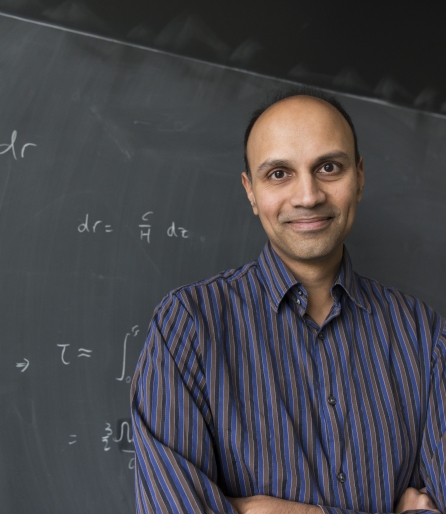
Teaching Affiliations
If you are interested in pursuing a MSc degree, please apply to the Perimeter Scholars International (PSI) masters program. If you are interested in working with me as a PhD student, please send me an email at [email protected]. Perimeter Institute is committed to diversity within its community and I welcome applications from underrepresented groups.
Research Interests
My research interests are primarily in the area of cosmology, including large-scale structure, dark matter, dark energy, and gravitational lensing.
Positions Held
- Professor, Department of Astronomy, University of Illinois Professor, 2011-2017
- Senior research associate, Canadian Institute for Theoretical Astrophysics, 2005-2011
- Postdoctoral Researcher, Institute for Advanced Study, 2002-2005
Recent Publications
- Dalal, N., & Percival, W. J. (2025). Estimating non-gaussian bias using counts of tracers. arxiv:2503.21024v1
- Dalal, N., Galanis, M., Gammie, C., Gralla, S. E., & Murray, N. (2024). Probing H0 and resolving AGN disks with ultrafast photon counters. Physical Review D, 109(12), 123029. doi:10.1103/physrevd.109.123029
- Massara, E., Percival, W. J., Dalal, N., Nadathur, S., Radinovic, S., Winther, H. A., & Woodfinden, A. (2022). Velocity profiles of matter and biased tracers around voids. Monthly Notices of the Royal Astronomical Society, 517(3), 4458-4471. doi:10.1093/mnras/stac2892
- Dalal, N., & Kravtsov, A. (2022). Excluding fuzzy dark matter with sizes and stellar kinematics of ultrafaint dwarf galaxies. Physical Review D, 106(6), 063517. doi:10.1103/physrevd.106.063517
- Xhakaj, E., Leauthaud, A., Lange, J., Hearin, A., Diemer, B., & Dalal, N. (2022). Beyond mass: detecting secondary halo properties with galaxy-galaxy lensing. Monthly Notices of the Royal Astronomical Society, 514(2), 2876-2890. doi:10.1093/mnras/stac941
- Dalal, N., & Kravtsov, A. (2022). Not so fuzzy: excluding FDM with sizes and stellar kinematics of ultra-faint dwarf galaxies. arxiv:2203.05750v2
Seminars
- Lecture - Cosmology, PHYS 621, Cosmology (Elective), PHYS 621, March 31 - May 2, 2025, 2025/04/29, PIRSA:25040024
- Lecture - Cosmology, PHYS 621, Cosmology (Elective), PHYS 621, March 31 - May 2, 2025, 2025/04/28, PIRSA:25040023
- Lecture - Cosmology, PHYS 621, Cosmology (Elective), PHYS 621, March 31 - May 2, 2025, 2025/04/24, PIRSA:25040022
- Lecture - Cosmology, PHYS 621, Cosmology (Elective), PHYS 621, March 31 - May 2, 2025, 2025/04/22, PIRSA:25040021
- Lecture - Cosmology, PHYS 621, Cosmology (Elective), PHYS 621, March 31 - May 2, 2025, 2025/04/17, PIRSA:25040020
- Lecture - Cosmology, PHYS 621, Cosmology (Elective), PHYS 621, March 31 - May 2, 2025, 2025/04/15, PIRSA:25040019
- Lecture - Cosmology, PHYS 621, Cosmology (Elective), PHYS 621, March 31 - May 2, 2025, 2025/04/14, PIRSA:25040018
- Lecture - Cosmology, PHYS 621, Cosmology (Elective), PHYS 621, March 31 - May 2, 2025, 2025/04/10, PIRSA:25040017
- Lecture - Cosmology, PHYS 621, Cosmology (Elective), PHYS 621, March 31 - May 2, 2025, 2025/04/08, PIRSA:25040016
- Lecture - Cosmology, PHYS 621, Cosmology (Elective), PHYS 621, March 31 - May 2, 2025, 2025/04/07, PIRSA:25040015
- Lecture - Cosmology, PHYS 621, Cosmology (Elective), PHYS 621, March 31 - May 2, 2025, 2025/04/03, PIRSA:25040014
- Lecture - Cosmology, PHYS 621, Cosmology (Elective), PHYS 621, March 31 - May 2, 2025, 2025/04/01, PIRSA:25040013
- Lecture - Cosmology, PHYS 621, Cosmology (Elective), PHYS 621, March 31 - May 2, 2025, 2025/03/31, PIRSA:25030001
- AGN HBT OMG, University of Chicago, Enrico Fermi Institute, Chicago, United States, 2025/03/03
- AGN HBT OMG, University of Pennsylvania, Physics, Philadelphia, United States, 2025/02/05
- AGN HBT OMG, Carnegie Observatories, Pasadena, United States, 2025/01/21
- AGN HBT OMG, Institute for Advanced Study, Princeton, United States, 2024/10/03
- AGN HBT OMG, McGill University, Physics, Montreal, Quebec, Canada, 2024/09/24
- AGN HBT OMG, University of California, Santa Barbara, Physics, Santa Barbara, California, United States, 2024/09/18
- AGN HBT OMG, Jet Propulsion Lab, La Cañada Flintridge, California, United States, 2024/09/16
- AGN HBT OMG, Kavli Institute for Particle Astrophysics and Cosmology, Menlo Park, California, United States, 2024/05/10
- AGN HBT OMG, Cosmological Frontiers in Fundamental Physics https://indico.ph.ed.ac.uk/event/277/, University of Edinburgh, Edinburgh, United Kingdom, 2024/04/20
- AGN HBT OMG, TAP Lectureship, University of Arizona, Astronomy, Tucson, AZ, United States, 2024/02/19
- AGN HBT OMG, Canadian Institute for Theoretical Astrophysics, Toronto, ON, Canada, 2023/09/27
- AGN HBT OMG, University of Illinois at Urbana-Champaign, Physics, Urbana, Illinois, United States, 2023/09/13
- Cosmology Lecture (230505), Cosmology (2022/2023), 2023/05/05, PIRSA:23050014
- Cosmology Lecture (230502), Cosmology (2022/2023), 2023/05/02, PIRSA:23050013
- Cosmology Lecture (230501), Cosmology (2022/2023), 2023/05/01, PIRSA:23050015
- Cosmology Lecture (230428), Cosmology (2022/2023), 2023/04/28, PIRSA:23040061
- Cosmology Lecture (230425), Cosmology (2022/2023), 2023/04/25, PIRSA:23040060
- Cosmology Lecture (230424), Cosmology (2022/2023), 2023/04/24, PIRSA:23040065
- Cosmology Lecture (230421), Cosmology (2022/2023), 2023/04/21, PIRSA:23040059
- Cosmology Lecture (230418), Cosmology (2022/2023), 2023/04/18, PIRSA:23040058
- Cosmology Lecture (230417), Cosmology (2022/2023), 2023/04/17, PIRSA:23040064
- Cosmology Lecture (230414), Cosmology (2022/2023), 2023/04/14, PIRSA:23040057
- Cosmology Lecture (230411), Cosmology (2022/2023), 2023/04/11, PIRSA:23040056
- Cosmology Lecture (230404), Cosmology (2022/2023), 2023/04/04, PIRSA:23040054
- Cosmology Lecture (230403), Cosmology (2022/2023), 2023/04/03, PIRSA:23040062
- Galaxies in the Axiverse, What is dark matter? - Comprehensive study of the huge discovery space in dark matter, Kavli Institute for the Physics and Mathematics of the Universe, Kashiwa, Japan, 2023/03/08
- Galaxies in the Axiverse, University of Pennsylvania, Philadelphia, Pennsylvania, United States, 2023/02/24
- Galaxies in the Axiverse, University of Washington, Astronomy, Seattle, United States, 2022/10/13
- Galaxies in the Axiverse, University of California, Berkeley, Astronomy, Berkeley, CA, United States, 2022/10/11